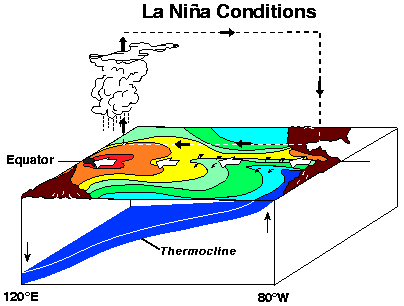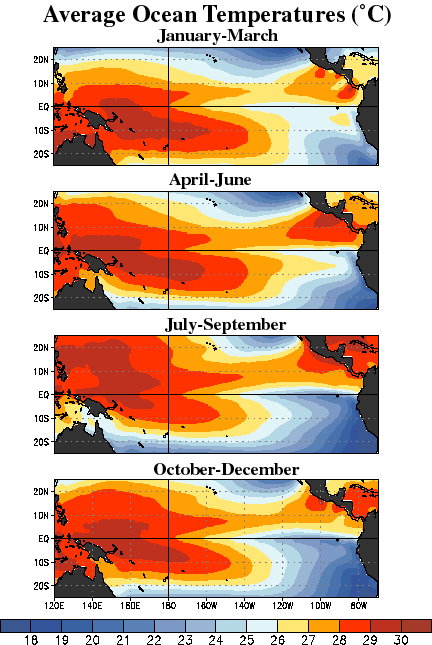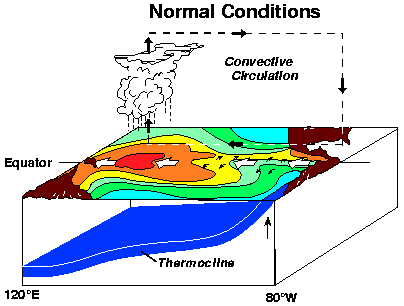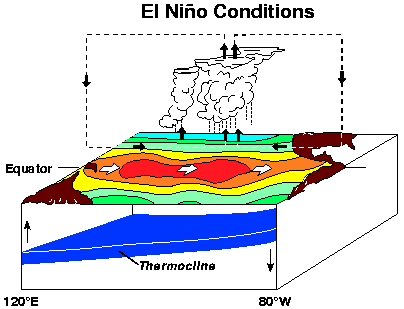El Nino
El Nino is a weather phenomenon that occurs in the Equatorial Pacific Ocean normally lasting between 6 to 18 months. First we should understand the normal conditions in the Equatorial Pacific Ocean to better understand about an El Nino.
Normal Conditions in the Equatorial Pacific Ocean (ENSO neutral) & LA Nina:
The Pacific Ocean stretches half way around the globe at the Equator from South American coast at 80W to Indonesia at 120 E. The Pacific ocean is very large and is divided into three parts viz. West Pacific, Central Pacific and East Pacific ocean. The ocean surface in the West Pacific is normally warm at around 29 C while the ocean surface temperature in the East Pacific is much cooler at around 22 C. to 26 C. depending upon the time of the year as shown in the seasonal changes of average ocean temperature map from CPC.
The ocean surface pressure is lower in the West Pacific compared to Central Pacific and East Pacific and hence Trade winds blow Westwards from the East Pacific towards the West Pacific. The ocean current also moves from East to West. Upwelling of cold water takes place near the coast of Peru/Equador. These deeper waters have nutrients that stimulate the growth of microscopic photosynthetic algae (“Phytoplankton“). Phytoplankton, in turn, serve as food for the zooplankton. Both phytoplankton and zooplankton serve as food for fish thereby increasing the fish production in the East Pacific.
Due to high ocean surface temperature in the West Pacific, there is evaporation and clouding and rain over West Pacific while the East Pacific there is dry condition. Sun heated warm water piles up in the West Pacific ocean and this is the reason why the temperature of the West Pacific ocean is higher than that of the East Pacific ocean.

La Nina is essentially the strengthening of the Normal conditions. During a La Nina, the trade winds strengthens further compared to Normal conditions, which causes the thermocline to tilt further, causing warm water to pool against Australia. The rain follows the location of the warm water, so Australia experiences above average rainfall, while South America experiences below average rainfall.
El Nino:
El Nino is a weather phenomenon that occurs in the Equatorial Pacific Ocean normally of 6 to 18 months time frame when there is an abnormal warming of surface ocean waters in the Eastern & Central Equatorial Pacific Ocean. This occurs when the normal trade winds weaken (or even reverse), which lets the warm water that is usually found in the western Pacific to flow instead towards the east. This warm water displaces the cooler water that is normally found near the surface of the eastern Pacific, setting off atmospheric changes that affect weather patterns in many parts of the world. Upwelling deep water near the coast of Peru/Equador is now warm and do not have nutrients that stimulate the growth of microscopic photosynthetic algae (“Phytoplankton“) and the zooplankton. This in turn decreases the fish production in the East Pacific. This is why these conditions are called El Niño which is Spanish for “the boy”, and the term El Niño refers to the Christ child, Jesus, because this periodic abnormal weather pattern is usually noticed around Christmas.
What happens to the ocean also affects the atmosphere. Tropical thunderstorms are fueled by hot, humid air over the oceans. The hotter the air, the stronger and bigger the thunderstorms. As the Pacific’s warmest water spreads eastward, the biggest thunderstorms move with it. Thus, rains which normally would fall over the tropical rain forests of Indonesia start falling over the central & east Pacific ocean along with deserts of Peru.
Southern Oscillation ( SOI )
The Southern Oscillation is the see-saw pattern of reversing surface air pressure between the eastern and western tropical Pacific; when the surface pressure is high in the eastern tropical Pacific it is low in the western tropical Pacific, and vice-versa. Because the ocean warming and pressure reversals are, for the most part, simultaneous, scientists call this phenomenon the El Nino/Southern Oscillation or ENSO for short.
During an El Nino higher than average air pressure covers Indonesia and the western tropical Pacific and below-average air pressure covers the eastern tropical Pacific. These pressure departures are reversed during La Nina, which features below-average air pressure over Indonesia and the western tropical Pacific and above-average air pressure over the eastern tropical Pacific.
The Southern Oscillation Index (SOI) is designed to measure the strength and phase of the Southern Oscillation. The SOI is calculated using departures from normal in the surface air pressure difference between Tahiti, French Polynesia and Darwin, Australia.
During El Nino episodes the SOI has a large negative value due to lower-than-average air pressure at Tahiti and higher-than-average pressure at Darwin.
During La Nina episodes the SOI has a positive value due to higher-than-average air pressure at Tahiti and lower-than-average pressure at Darwin.





You have very nicely explained the occurrence and effect of both El Nino and La Ninya.
Plz your whatsapp number my number whatsapp 8605655239
sir sourasat varo have kyare aavse
jamnagar jila na jamjodhpur lalpur bhanvad ma haju vavni layak varsad nathi
Biyaran toe chhene ?
Sir, what is the likely date of monsoon in Ahmedabad in 2016?
I do not forecast for more than 7 days, so cannot comment on Monsoon for Ahmedabad.
Sir , su 2016 ma saurasthra ma monsoon valu 6. Su monsoon season rainfall kevo 6.saro k kharab 2016 ma
Sir please inform the starting date of monsoon of saurasthra
sir
i read your analysis on akila, i wath to contact you to know more about e nino. i ask for your phone number to kaila, but they refuse.i am journalist at surat. please give your phone number.
I have sent you an email today.
Sir please update for alnino/ lanino effect on next monsoon season
Dear Mr Patel
I am an Indian Air Force Meteorologist . I am impressed with your effort to maintain the website and provide Gujarat relevant weather information .
I had been using Davis type instrument in one of the UN missions and it was providing good services . I think it is a good robust system easy to maintain .
Wishing you the best
Ravinder
Thanks for the compliments.
Nice and easy explaination